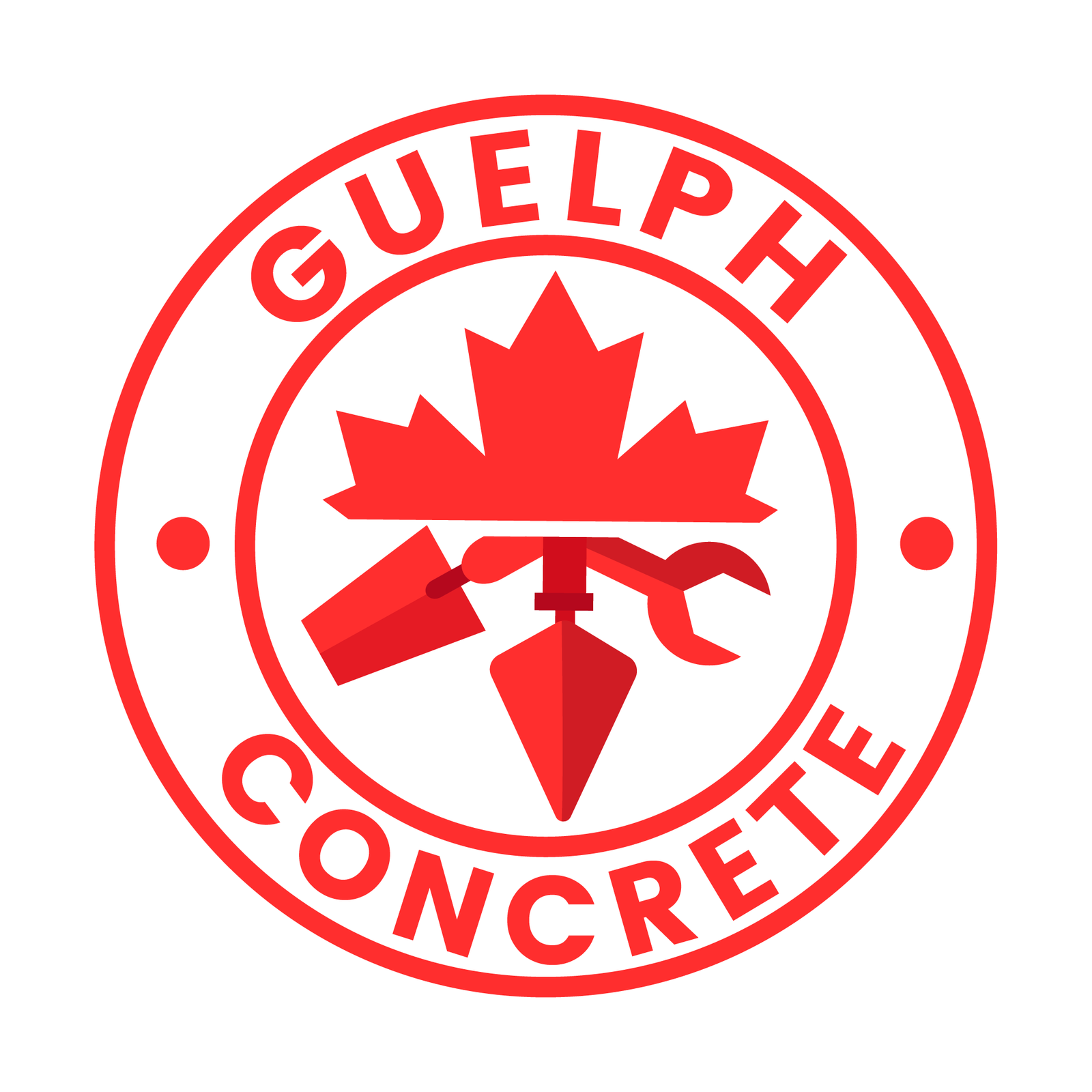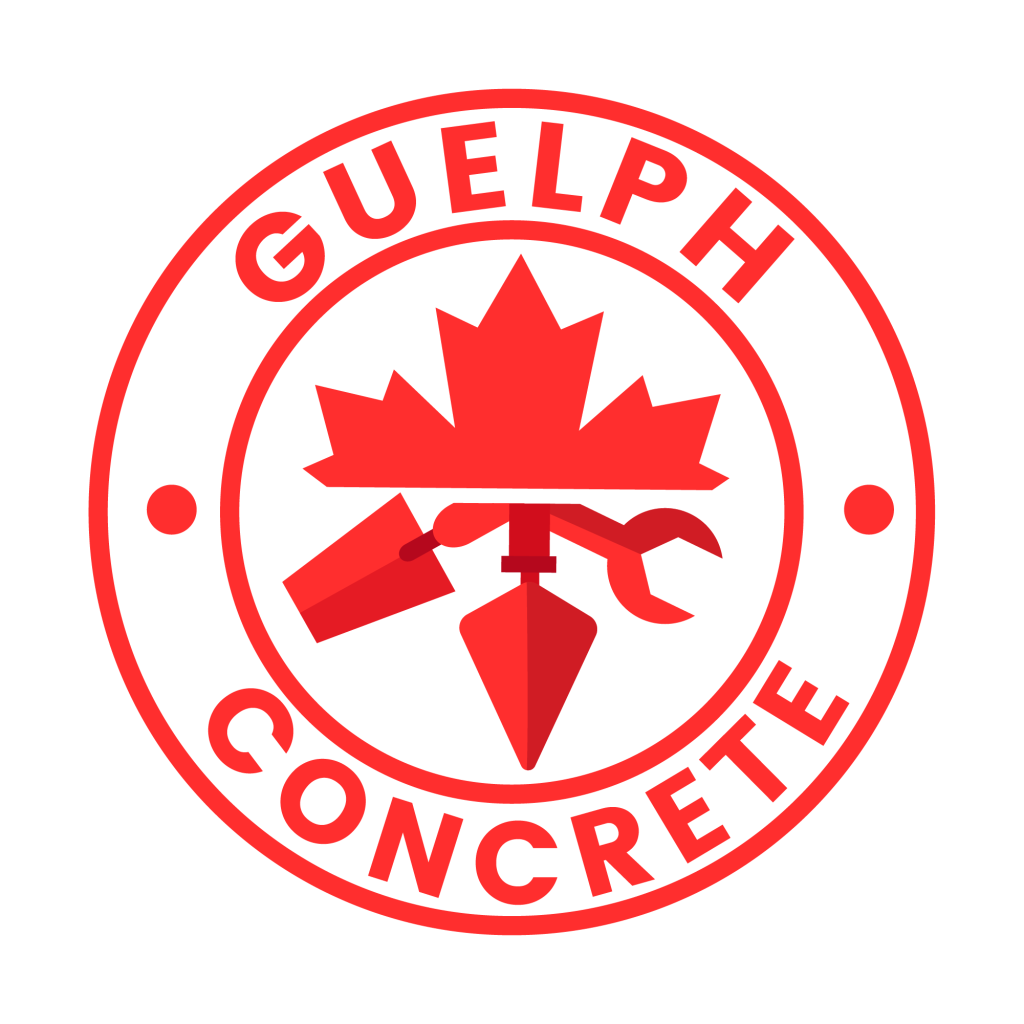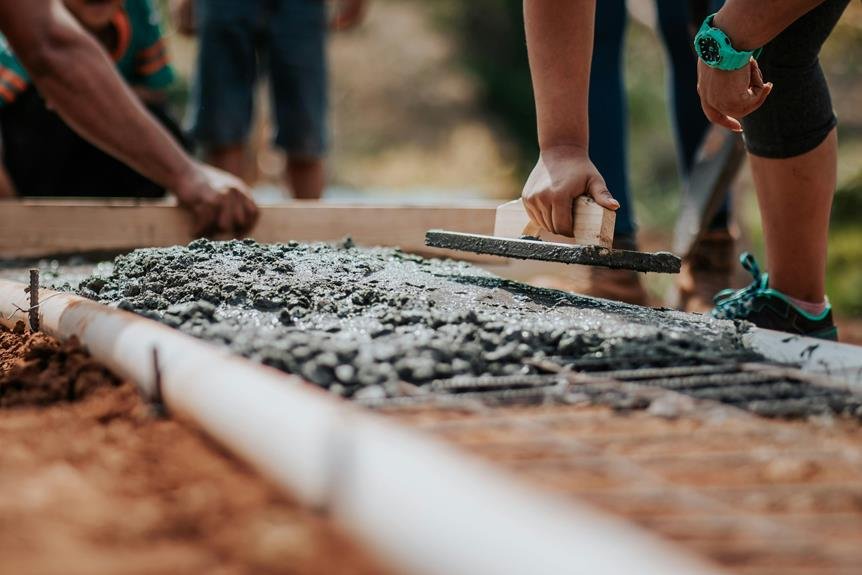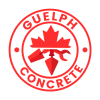Let’s get started on waterproofing your foundation in Guelph, Ontario! At Guelph Concrete LTD, we have over 15 years of experience in the industry, ensuring that your foundation remains solid and dry.
First, we assess the site, checking soil and drainage conditions. Next, we thoroughly clean the foundation walls and repair any cracks. Choosing a top-quality membrane is essential; we ensure that it’s both durable and flexible.
We’ll evenly apply primer for optimal adhesion, then cut and secure the membrane in place. Sealing joints properly with suitable materials like butyl or EPDM rubber is vital for long-lasting results.
Finally, we meticulously inspect the installation for any gaps or tears to guarantee a flawless finish.
For a free estimate on your foundation waterproofing project, contact Guelph Concrete LTD at 548-490-2074. Let our expertise protect your home from water damage!
Assessing the Site
Before we start installing the waterproofing membrane, let’s thoroughly assess the site to make sure the foundation is in good shape. A solid foundation is key to a successful waterproofing job, so we need to take our time with this step.
First, let’s perform a thorough site assessment. We’ll check the soil composition around the foundation. Different soils have varying levels of water retention, and clay, for example, can hold a lot of moisture. Knowing this helps us anticipate potential water issues.
Next, we’ll conduct a detailed foundation inspection. Look for any signs of water damage or existing cracks. Water stains, efflorescence, or mold can indicate past or current leaks. If we spot any issues, we’ll need to address them before moving forward.
We should also verify that the drainage systems around the site are functioning correctly. Poor drainage can lead to water pooling around the foundation, increasing the risk of leaks. Ensuring that gutters, downspouts, and drainage tiles are in good working order is essential.
Preparing the Foundation
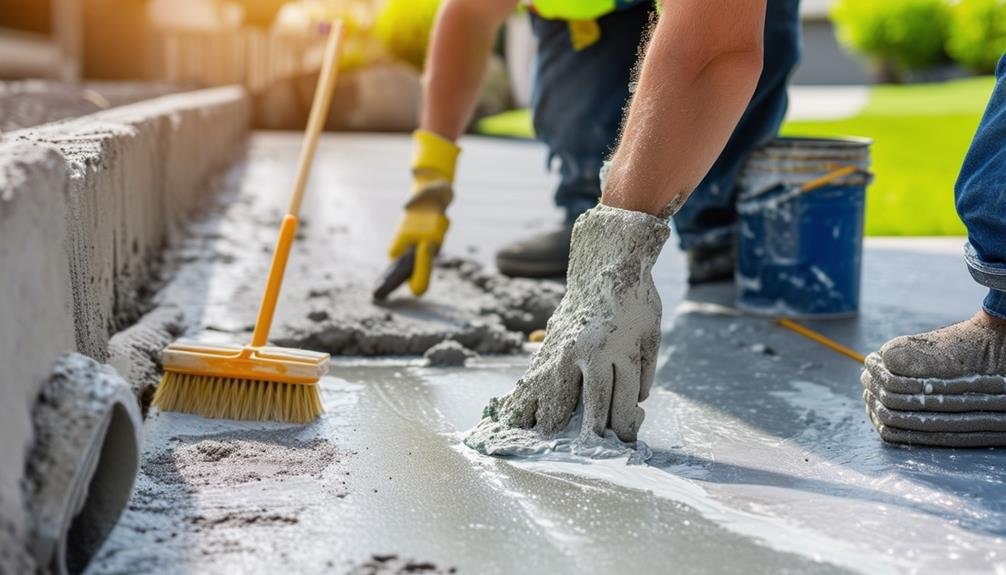
Let’s start by thoroughly cleaning the foundation wall surface to remove any dirt, debris, or contaminants that could affect the membrane’s adhesion. A clean surface is vital for successful waterproofing preparation. We’ll need to use wire brushes, power washers, or even a simple garden hose, depending on the extent of buildup.
After cleaning, let’s focus on foundation assessment. We need to inspect the wall for any cracks or imperfections. These must be repaired to create a smooth surface for the membrane installation. Filling these cracks with a high-quality sealant won’t only prepare the wall but also add an extra layer of protection.
Ensuring the foundation is dry is another important step. Moisture can severely impact the membrane’s effectiveness. If the wall is damp, we should allow it to dry completely before moving forward.
Lastly, we need to check the slope and drainage around the foundation. Proper drainage prevents water accumulation, which is necessary for effective waterproofing.
Here’s a quick checklist to guide us through the process:
- Surface Cleaning: Remove all dirt, debris, and contaminants.
- Foundation Assessment: Inspect for cracks and imperfections.
- Crack Repair: Fill and seal all identified cracks.
- Drying and Drainage: Ensure the wall is dry and check for proper slope and drainage.
Selecting the Membrane
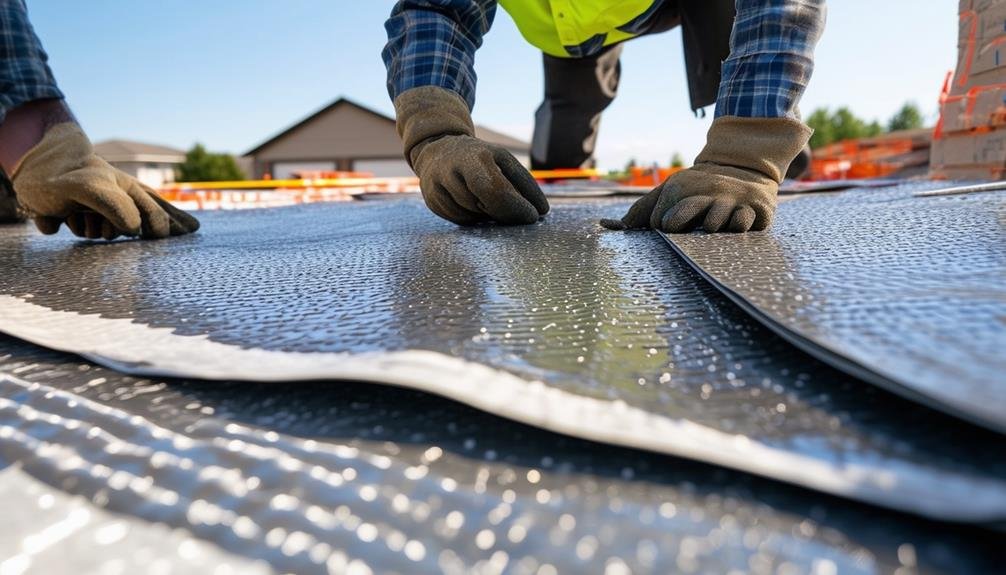
When selecting the right waterproofing membrane for our foundation in Guelph, Ontario, we need to take into account factors like durability, flexibility, and compatibility with the foundation material. High-quality waterproofing membranes are essential for making sure that our basement stays dry and protected from water infiltration.
To start, we should consider the specific requirements of our project. Not all membranes are created equal, so membrane selection is vital. We want a product that’s both durable and flexible to withstand ground movement and temperature changes typical in Guelph. It’s also important that our chosen waterproofing membrane is compatible with the foundation material we’re working with.
Checking for manufacturer’s warranties and certifications can provide additional peace of mind about the membrane’s effectiveness and longevity. It’s always a good idea to consult with waterproofing experts in Guelph. They can offer valuable recommendations tailored to our particular needs, helping us make the best decision.
A few installation tips to keep in mind: make sure the surface is clean and smooth before applying the membrane, and follow the manufacturer’s guidelines closely.
Applying the Primer
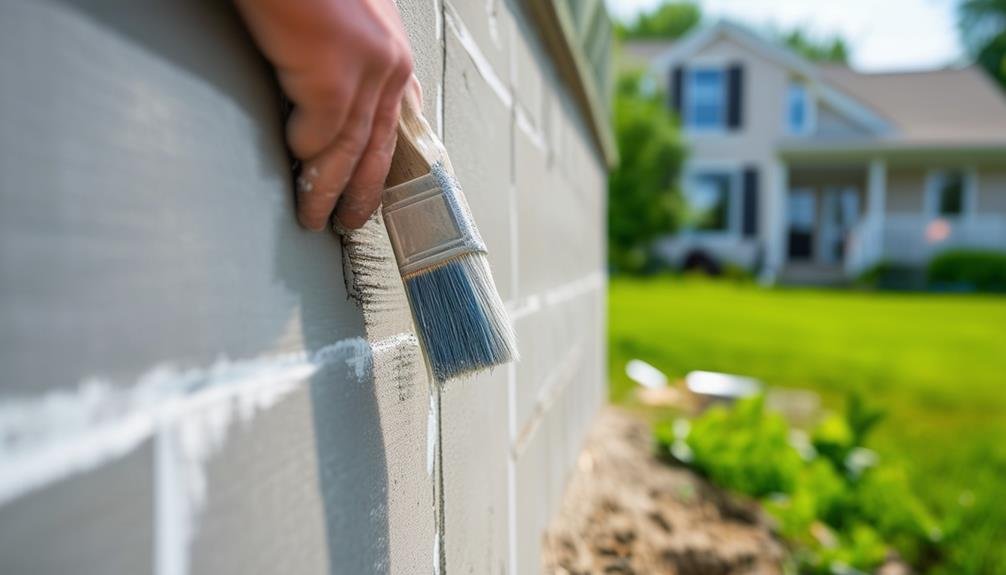
To guarantee our waterproofing membrane adheres properly, we need to start by applying a high-quality primer to the clean, dry surface of the foundation. This step is vital for creating a strong bond and maximizing the membrane’s effectiveness.
Here’s how we can nail the primer application:
- Prep the Surface:
Make sure the foundation surface is clean and dry. Remove any loose debris, dirt, or old paint to optimize primer coverage.
- Apply Evenly:
Using a brush or roller, apply the primer evenly across the foundation. Follow the manufacturer’s instructions closely to ensure ideal adhesion techniques.
- Mind the Drying Time:
Allow the primer to dry completely. This might take a few hours, but it’s crucial for creating a strong bond. Check the manufacturer’s guidelines for specific drying times.
- Inspect Your Work:
After the primer has dried, inspect the surface for any missed spots or uneven coverage. Reapply if necessary to achieve a uniform layer.
Cutting the Membrane
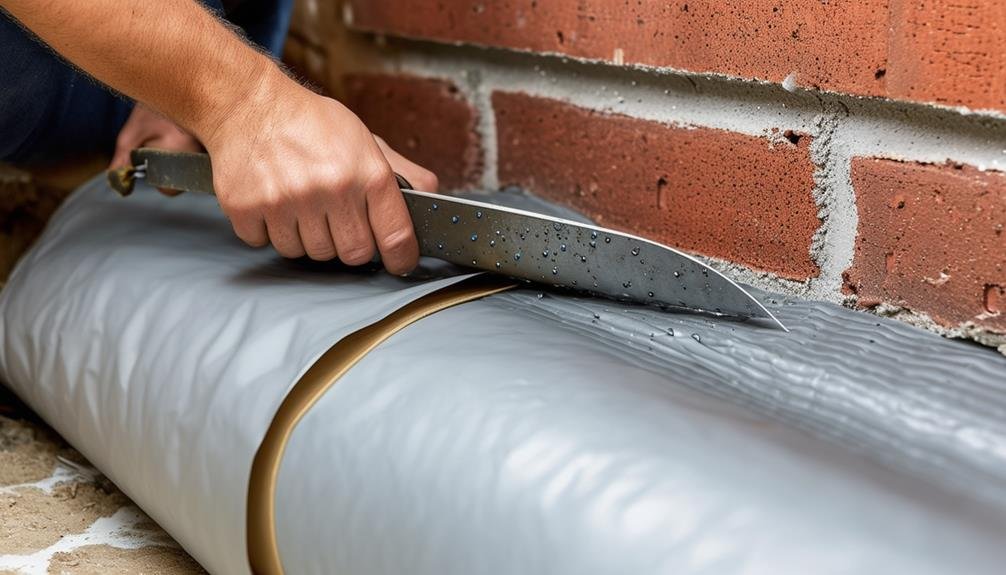
At Guelph Concrete LTD, we take pride in ensuring that every project is executed with precision and care. With over 15 years of experience serving Guelph, Ontario, we know the importance of cutting the membrane to fit your foundation perfectly.
Our process begins by meticulously measuring the wall dimensions. We then use a utility knife or scissors for precise cuts, ensuring that the membrane overlaps at seams and corners to create a seamless waterproofing barrier.
For a flawless foundation and expert waterproofing, contact Guelph Concrete LTD for a free estimate.
Call us today at 548-490-2074.
Measuring for Precise Fit
Let’s start by accurately measuring the height and length of the foundation wall to determine the exact size of the waterproofing membrane needed. Getting these measurements right is vital for ensuring that the membrane fits perfectly and provides effective water protection.
Here’s how we can achieve precise sizing and cutting:
- Measure Twice: Record the height and length of the foundation wall meticulously. This guarantees we get the waterproofing membrane sizing correct.
- Allow for Overlaps: Plan for the membrane to overlap by a few inches at seams and corners. This overlap is essential to preventing water from seeping through any gaps.
- Mark Your Cuts: Using a measuring tape and chalk line, mark where you’ll make your cuts on the membrane. Precision cutting techniques start with clear, straight lines to follow.
- Cut Carefully: Utilize a sharp utility knife to cut along the marked lines. Clean cuts will help in seamless application and adherence to the foundation wall.
Cutting Techniques and Tools
When cutting the foundation waterproofing membrane, we should use a sharp utility knife or scissors to ensure clean, precise edges that will form an effective water barrier. Cutting accuracy is vital to guarantee the membrane fits snugly around corners, protrusions, and irregular surfaces. Using the right tools and proper techniques, we can achieve a seamless and secure installation.
First, let’s make certain our utility knife or scissors are sharp. Dull tools can lead to jagged edges, compromising the membrane’s integrity. For precision cutting, we should follow the manufacturer’s guidelines to maintain the membrane’s effectiveness. This involves measuring and marking the membrane carefully before making any cuts.
Next, when cutting, smooth and steady motions are crucial. Rushing through this step can result in uneven edges that may not adhere properly, leading to potential water infiltration. We should also guarantee that the membrane overlaps correctly at the seams for a continuous protective seal.
Attaching the Membrane
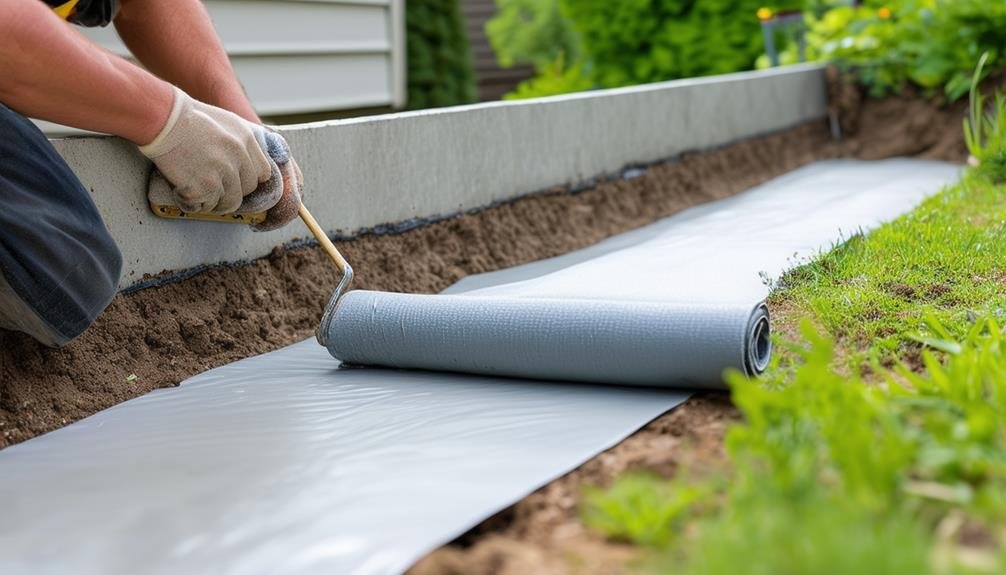
Before we attach the waterproofing membrane, we’ll need to make sure the foundation surface is clean, dry, and free from debris. This step is vital to guarantee that the membrane adheres properly and forms a strong barrier against water intrusion.
Next, we’ll look at our options for attaching the membrane. We’ve two main methods: adhesive application and fastener options. Depending on the product and the condition of our foundation, we might choose one or a combination of these methods.
Here’s a step-by-step guide to help us through the process:
- Apply Adhesive: Spread the adhesive evenly on the foundation wall using a trowel or roller. Make sure to follow the manufacturer’s instructions regarding drying time and temperature requirements.
- Position the Membrane: Carefully unroll the membrane and press it onto the adhesive. Start from the bottom and work your way up to avoid trapping air bubbles.
- Fastener Options: If we’re using mechanical fasteners, place them at regular intervals along the top edge of the membrane, ensuring they’re tight but not tearing the material.
- Overlap Edges: Overlap the edges of the membrane according to the manufacturer’s guidelines to create a seamless barrier.
These steps will help us securely attach the waterproofing membrane, giving our foundation the protection it needs.
Sealing the Joints
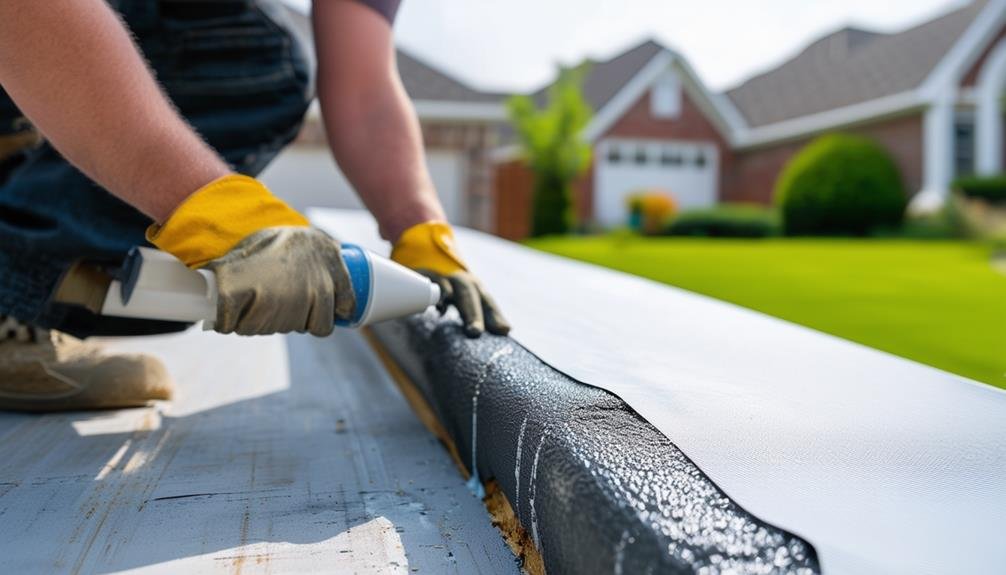
Now that we’ve attached the membrane, let’s focus on sealing the joints properly. At Guelph Concrete LTD, with over 15 years of experience in Guelph, Ontario, we know the importance of using high-quality materials to ensure these areas are watertight. By applying the right techniques, we prevent any water from sneaking through these critical points.
For a reliable and professional approach to your concrete needs, contact Guelph Concrete LTD for a free estimate. Call us today at 548-490-2074.
Proper Joint Sealing Techniques
To protect our foundation from moisture, we need to begin by using high-quality sealants to fill any gaps and cracks. Sealant application is crucial for waterproofing effectiveness, so let’s discuss some practical tips for getting it right.
First, make certain the areas we’re sealing are clean and dry. Dirt and moisture can compromise the sealant’s adhesion, reducing our efforts’ effectiveness.
Here’s a simple step-by-step guide to guarantee we do it correctly:
- Clean the Joints: Utilize a wire brush and vacuum to eliminate any debris or dust. Clean surfaces guarantee the sealant adheres properly.
- Apply Primer: If the manufacturer suggests it, apply a primer to the joints. This enhances the connection between the sealant and the foundation.
- Sealant Application: Apply the sealant in a continuous and uniform manner. This uniformity is crucial in preventing water from seeping through any small gaps.
- Smooth the Sealant: Use a putty knife or a similar tool to even out the sealant. This not only looks tidy but also ensures a secure seal.
Materials for Joint Sealing
With our joints properly sealed, let’s explore the materials that will keep water from infiltrating our foundation. In Guelph, we need to be mindful of our unique environmental conditions, which is why selecting the right materials is essential. We’ve got several options, including butyl rubber, EPDM rubber, PVC, and thermoplastic rubber. Each of these offers flexibility, durability, and impressive resistance to water penetration.
Now, let’s talk membrane types. Butyl rubber is great for its long-lasting properties, while EPDM rubber stands out for its exceptional flexibility. PVC is another solid choice, known for its strength and adaptability. Thermoplastic rubber, on the other hand, offers a perfect blend of flexibility and durability.
During the installation process, these materials come in various forms like tapes, sheets, and even liquid membranes, making them versatile for different applications. We should always consider our foundation type and construction method to make sure we pick the right material.
Inspecting the Installation
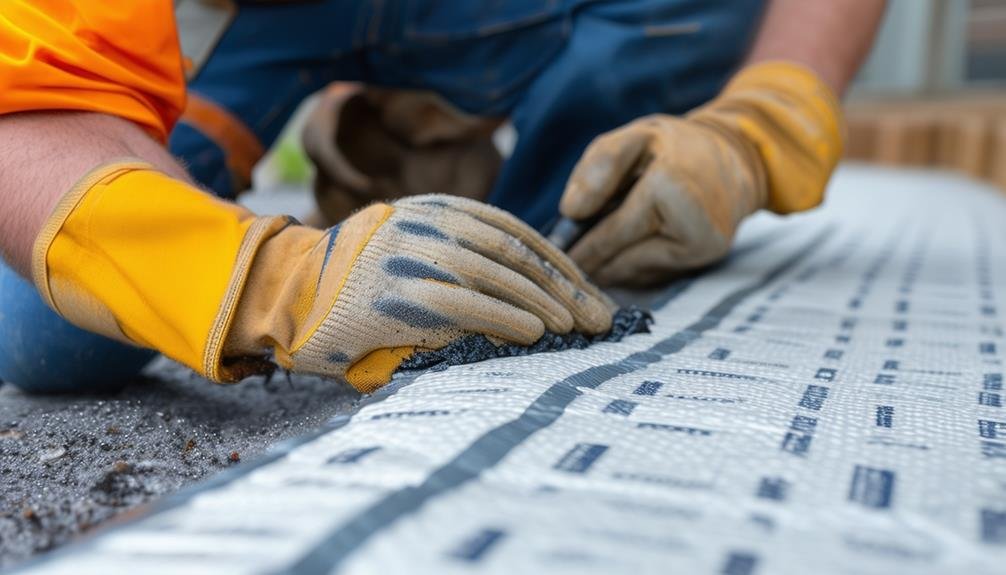
Before declaring the job complete, let’s carefully inspect the foundation to verify that the waterproofing membrane is flawlessly installed. This step is essential for quality control and installation validation, ensuring everything is up to standard and will effectively keep water at bay.
Here’s a handy checklist to follow:
- Surface Cleanliness and Smoothness: Make sure the foundation surface is free of debris, clean, and smooth. Any dirt or rough patches could compromise the membrane’s adhesion and effectiveness.
- Crack and Damage Inspection: Look for any cracks or damages in the foundation that might’ve been overlooked. These need to be repaired before the membrane application to prevent future issues.
- Membrane Overlap and Adherence: Check that the membrane overlaps correctly and is securely adhered to the foundation. Proper overlapping and adhesion are key to preventing water seepage.
- Tears, Gaps, and Bubbles: Inspect the membrane for any tears, gaps, or bubbles. These imperfections can compromise the waterproofing and must be addressed immediately.
Additional Waterproofing Measures
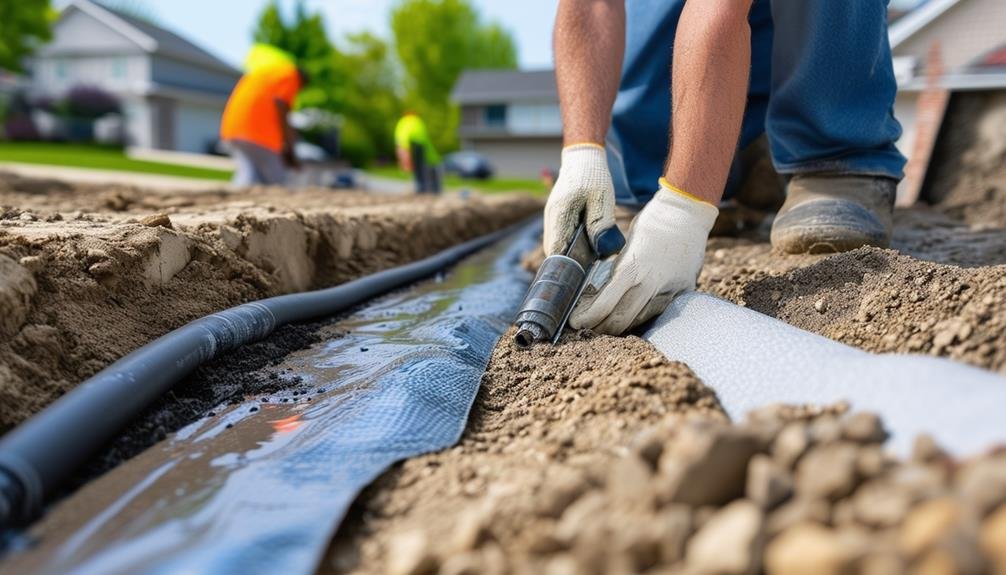
At Guelph Concrete LTD, with over 15 years of experience serving Guelph, Ontario, we understand the importance of robust foundation waterproofing. To enhance our already effective solutions, we recommend a few additional measures.
Installing weeping tiles and sump pumps can provide advanced drainage solutions to keep water at bay. Additionally, applying exterior waterproofing coatings and maintaining gutters will guarantee that we tackle moisture from all angles.
For a free estimate on how we can protect your foundation, contact Guelph Concrete LTD today at 548-490-2074. Let our expertise keep your property safe and dry.
Advanced Drainage Solutions
When it comes to keeping our basements dry in Guelph, Ontario, advanced drainage solutions like weeping tile systems, French drains, and sump pumps are essential allies. These systems work hand-in-hand with foundation waterproofing membranes to ensure our homes stay protected from water damage.
To manage drainage effectively, we should consider incorporating these advanced measures:
- Weeping Tile Systems: These underground pipes help direct water away from the foundation. Proper drainage management and landscape design can enhance their efficacy.
- French Drains: By utilizing a trench filled with gravel and a perforated pipe, French drains can divert rainwater, offering excellent foundation protection.
- Sump Pumps: Installing a sump pump in the basement can efficiently remove accumulated water, especially during heavy rainfall or snowmelt.
- Rainwater Diversion: Gutter extensions and downspout redirection can markedly reduce the amount of water reaching the foundation, preventing potential leaks and damage.
Effective Moisture Barriers
While advanced drainage systems are excellent for redirecting water away, we also require efficient moisture barriers like foundation waterproofing membranes to maintain our basements dry and shielded. These membranes play a vital role in moisture prevention and foundation protection, serving as an external shield against water infiltration.
To set up a foundation waterproofing membrane, we commence by applying a sturdy material to the outer surface of the foundation walls. This establishes a continuous barrier that blocks water seepage and potential structural problems. Using quality materials and following correct waterproofing techniques is necessary to guarantee enduring outcomes. This step is particularly crucial in Guelph, where weather conditions can be harsh and unpredictable.
Paying attention to details is crucial. We must make certain that the membrane is evenly applied and covers all possible moisture entry points. Properly overlapping the edges and sealing seams can significantly enhance its effectiveness. With the appropriate approach, our waterproofing membrane won’t just maintain our basements dry but also prolong the life of our foundation.
Let’s keep in mind, a well-protected foundation is the foundation of a secure and cozy home. Therefore, dedicating time and energy to efficient moisture barriers yields benefits in the long term.
Maintenance Tips
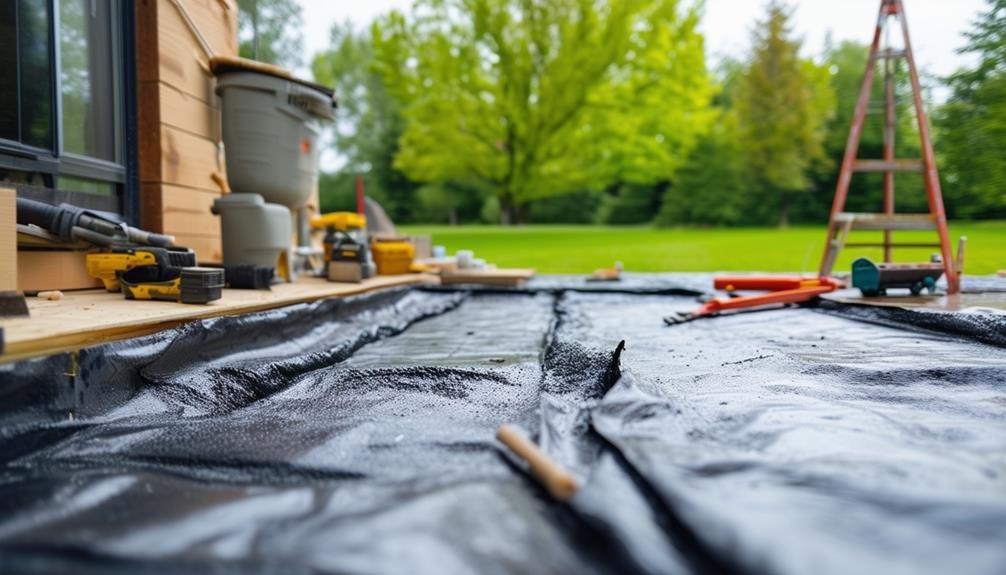
Let’s keep our foundation waterproofing membrane in top shape by regularly inspecting it for any signs of damage or wear. Regular maintenance guarantees that we protect our homes from water damage and prolong the life of the membrane.
Here are some practical tips to help us maintain our waterproofing membrane effectively:
- Surface Preparation:
Before we get into membrane maintenance, let’s make sure the surface is clean. Remove any dirt, debris, or contaminants that could compromise the membrane’s effectiveness. A clean surface ensures that any repairs or inspections are accurate.
- Routine Inspections:
Regularly check the membrane for cracks, gaps, or any signs of deterioration. Early detection can save us from expensive repairs down the line. Make it a part of our seasonal home maintenance routine.
- Maintain Proper Drainage:
Check the drainage around the foundation to prevent water buildup. Proper drainage systems keep excess water away from the membrane, reducing the risk of damage.
- Professional Maintenance:
Sometimes, it’s best to call in the pros. Consider professional maintenance services to assess the condition of the membrane. They can make any necessary repairs or replacements that we might miss.
Frequently Asked Questions
How to Install Waterproofing Membrane on Foundation?
We start by cleaning the foundation, then apply a high-quality waterproofing membrane like Bakor WP200 for proper sealing. Overlapping seams guarantees moisture protection. Following the manufacturer’s guidelines, we achieve a smooth, even, and effective waterproof barrier.
What Is the Best Method of Foundation Waterproofing?
Like a shield protecting a knight, the best method of foundation waterproofing is exterior waterproofing. We’ve got several waterproofing options, including membrane installation techniques, ensuring we keep our foundations dry and secure.
How to Install a Drainage Membrane?
Let’s install the drainage system together! Clean the foundation, apply adhesive, and secure the waterproofing membrane. Overlap edges, use a roller, and inspect for gaps. For maintenance, check and seal any areas regularly to guarantee effectiveness.
How Long Must You Wait to Apply Waterproofing to New Foundations?
For the best results, we should wait at least 7 days to guarantee proper curing time before starting the application process. This secures our foundation’s fully cured, guaranteeing maximum adhesion and effectiveness of the waterproofing membrane.
Conclusion
So there you have it, folks! We’ve walked through the steps, from evaluating the site to maintaining your waterproofing membrane.
Remember, a well-protected foundation is like a sturdy umbrella on a rainy Guelph day—it keeps everything safe and dry.
Don’t cut corners; a little effort now can save a lot of trouble down the road. Let’s get those foundations secure and keep our homes cozy and dry, no matter what the weather throws at us!
